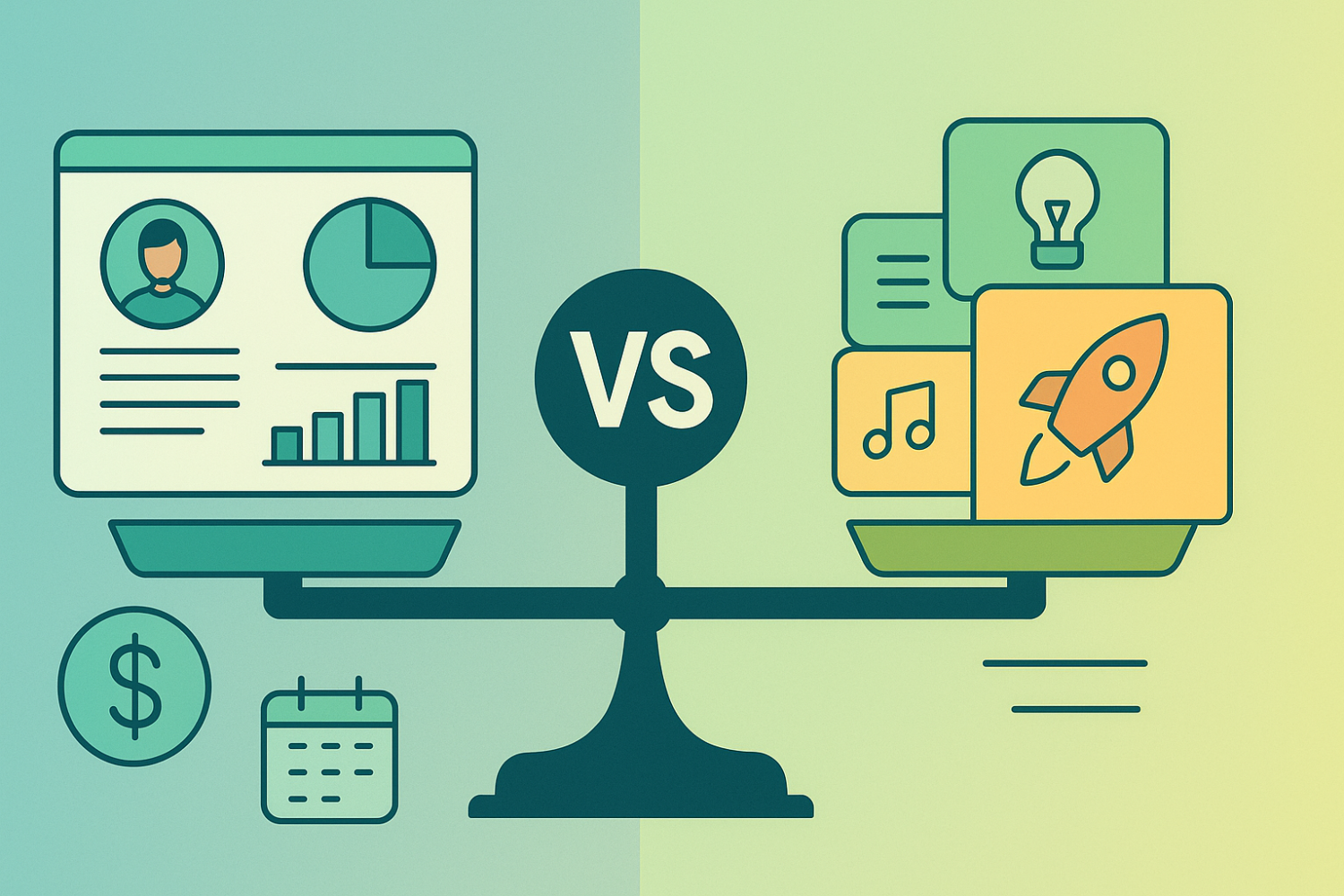Upwork vs Fiverr: Choosing the Right Freelancing Platform in 2025

Introduction to Freelancing Platforms
In recent years, freelancing platforms have gained considerable traction, evolving from niche markets into mainstream avenues for employment and service provision. By 2025, platforms such as Upwork and Fiverr have solidified their positions as key players in the gig economy, serving a diverse range of needs from graphic design to content writing. This rise is indicative of a broader shift in work dynamics, as more individuals opt for flexible employment options over traditional 9-to-5 jobs.
The gig economy presents an array of opportunities that cater to both freelancers and clients. Freelancers can promote their skills on platforms like Upwork and Fiverr, allowing them to find jobs that fit their expertise and schedule. For clients, these platforms offer a reservoir of talent, making it easier to procure services without the complexity of long-term contracts or commitments. This dynamic flexibility has broadened the scope of freelance work, creating a marketplace that thrives on efficiency and accessibility.
As we examine the intricacies of Upwork vs Fiverr, it is essential to recognize the distinct service offerings of each platform. While Upwork provides a more extensive range of freelance services, including long-term projects and hourly contracts, Fiverr operates primarily on a per-task basis, which can be more attractive for clients looking for specific deliverables. Understanding these differences between the platforms is crucial for freelancers aiming to maximize their potential and for clients focused on sourcing high-quality work.
In this era of digital work, the ability to navigate through various freelancing platforms is paramount. As freelancers and companies increasingly rely on sites like Upwork and Fiverr, a clear understanding of each platform can significantly enhance user experience and satisfaction. Moving forward, it is vital for individuals engaging with these platforms to assess their specific needs and goals, whether it be through Upwork's comprehensive guide for 2025 or a targeted Fiverr evaluation.
Pricing Structures: Upwork vs Fiverr
When evaluating the various freelancing platforms available today, the pricing structures of Upwork and Fiverr are pivotal aspects to consider. Both platforms present their own unique models that significantly influence the experience of freelance workers and their clients.
Upwork features a dual pricing approach: hourly rates and fixed project-based pricing. Freelancers on Upwork have the flexibility to set their own hourly rates, which vary significantly based on expertise and market demand. Clients can also opt for fixed bids for specific projects, which necessitate precise quoting. This model allows for transparency and negotiation, ensuring that both parties understand the financial commitment upfront. However, Upwork does implement service fees, which can be as high as 20% on the first $500 earned per client, gradually decreasing as freelancers build their earnings on the platform.
In contrast, Fiverr adopts a gig-based pricing structure, where services are offered in pre-defined packages, starting at $5. This model attracts a diverse array of buyers looking for affordable options and allows freelancers to showcase their skills through specific service offerings. On Fiverr, freelancers can set tiered pricing for different levels of service, which can lead to potential upsell opportunities. Notably, Fiverr charges a 20% commission on all transactions, making it crucial for freelancers and clients to account for these fees when budgeting for projects.
In this freelancing platforms comparison, understanding how these pricing structures affect overall cost-effectiveness is essential. Determining if Fiverr or Upwork is the better choice ultimately depends on individual budgetary constraints and project requirements. By analyzing how both platforms charge for services, freelancers and clients can make informed decisions that best suit their financial goals and project needs.
Types of Jobs and Projects Available
When considering freelancing platforms like Upwork and Fiverr, it's important to understand the variety of jobs and projects each one offers. Both sites cater to a wide range of industries, but they do so with distinct approaches and specific niches. This analysis aims to provide a comprehensive comparison of Upwork vs Fiverr, focusing on the types of opportunities available on these platforms.
Upwork primarily serves freelancers looking for long-term projects or ongoing contracts. It features a robust array of job categories, including software development, writing, marketing, graphic design, and customer service. Clients tend to post projects that require specialized skills or ongoing collaboration, which often results in higher hourly or project-based rates. For instance, a freelancer skilled in web development may find ample opportunities on Upwork, as businesses frequently seek developers for complex, large-scale projects.
In contrast, Fiverr is known for its gig-based model, where freelancers offer clearly defined services at set prices beginning at five dollars. This platform is highly effective for freelancers who specialize in niche services such as social media management, logo design, or voiceover work. The nature of Fiverr allows clients to easily browse and purchase specific services, making it an attractive option for those with defined project needs. Many freelancers find success by crafting specialized gigs that cater to popular demands, thus shining a light on their unique skill sets.
Choosing which platform to use ultimately depends on the types of projects freelancers are seeking. Those looking for extensive opportunities and complex job requests may find Upwork more suitable. Conversely, freelancers with specialized services might benefit from the gig-oriented approach of Fiverr. Hence, understanding the job categories and project types on each platform is fundamental for freelancers aiming to align their expertise with the best freelancing websites available in 2025.
User Experience and Opportunities for Freelancers
When evaluating the user experience on freelancing platforms, Upwork and Fiverr present distinct interfaces that cater to varying freelancer needs. Upwork, known for its robust and extensive features, provides a comprehensive dashboard where freelancers can manage their projects, proposals, and communications seamlessly. The platform offers a rich array of filters and search options, allowing freelancers to find jobs that align closely with their skills and interests. On the other hand, Fiverr operates on a straightforward model, where freelancers create service listings, or gigs, that potential clients can easily browse. This simplicity facilitates quicker understanding and engagement, especially for newcomers to freelancing.
In terms of navigation, both platforms excel but serve different purposes. Upwork’s layout emphasizes job postings and applicant tracking, which benefits more experienced freelancers seeking ongoing work relationships. Conversely, Fiverr's interface is designed for quick service offerings, making it easier for freelancers to showcase and sell specific skills instantly. Furthermore, communication tools such as messaging systems and feedback mechanisms on both platforms enhance user interaction. Upwork’s messaging feature allows for detailed project discussions, while Fiverr’s review system encourages transparency and trust through client feedback.
Opportunities for freelancers vary between these platforms as well. Upwork prides itself on support for career growth, offering various resources, webinars, and community forums. Freelancers can receive valuable insights from peers, enhancing their professional development. In contrast, Fiverr, while more gig-focused, empowers freelancers by enabling them to set their pricing, enhancing job security through clear service offerings. The choice of platform ultimately rests on individual career goals; understanding the user experience of each is crucial in deciding the more suitable option. Thus, for freelancers evaluating Upwork vs Fiverr in 2025, it's essential to consider which environment aligns with their aspirations and preferred working style.









